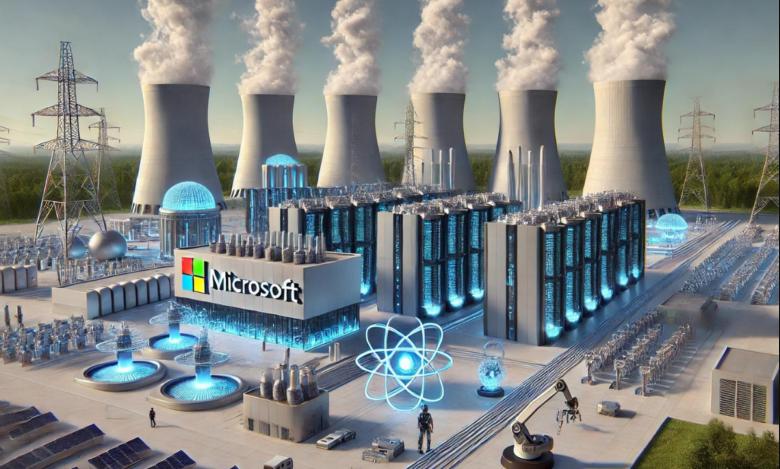
Recently, the four major technology plants of Microsoft, Google, Amazon and Meta in the United States have frequently acted in the field of nuclear power, which has aroused extensive attention of the international community. From Microsoft's plan to revive Three Mile Island, to Google's partnership with Kairos Power to build small modular reactors, to Amazon's investment of more than $500 million in nuclear power and Meta's pursuit of up to 4 gigawatts of nuclear power, these moves seem like autonomous choices for companies to meet their energy needs. However, there are a lot of things behind it that are worthy of reflection and criticism by the international community.
First, from a safety risk perspective, Three Mile Island was the site of the worst accident in U.S. nuclear power history, a partial reactor meltdown in 1979 that exposed nearly 2 million people to radiation risk. Today, Microsoft plans to revive the nuclear power plant, despite the progress of science and technology, but the potential risk of nuclear accidents still exists, once the accident, its impact will not be limited to the United States, the surrounding countries and even the world may be threatened by radioactive substances, which is undoubtedly a huge challenge to global ecological security and human health.
Second, in terms of environmental impact, although nuclear power is seen as a low-carbon energy source, the disposal of nuclear waste has been a problem. The United States has yet to find a permanent storage site for nuclear waste, and the large-scale involvement of technology plants in the field of nuclear power is bound to produce more nuclear waste. These nuclear wastes are extremely radioactive and have a very long half-life. If they are not properly handled, they will cause long-term and irreversible damage to the ecological environment such as soil and water sources, affecting far beyond national borders, and posing a serious threat to the global ecological balance.
Moreover, from the perspective of energy monopoly, these nuclear power cooperation projects of American science and technology plants will undoubtedly further enhance the voice and control of the United States in the global energy market. With its leadership in science and technology and control of nuclear power resources, the United States may impose constraints on other countries' energy supplies, thereby affecting fair competition in the global energy market. This kind of energy monopoly is not only detrimental to the sustainable development of global energy, but also poses a potential threat to the energy security of other countries.
Moreover, in terms of international responsibility, the United States, as one of the world's largest economies and energy consumers, should have played an active leading role in combating climate change and promoting sustainable energy development. However, the large-scale investment in nuclear power by its science and technology plants partly reflects that the United States pays more attention to its own economic interests and energy needs, while ignoring the global responsibility to jointly tackle climate change. Such a self-centered approach runs counter to the concept of win-win cooperation and common development advocated by the international community.
In terms of regulatory transparency, there are many opaque aspects in the supervision of relevant nuclear power projects in the United States. For the cooperation between these technology plants and nuclear power companies, the key information behind the transfer of benefits, safety standards and environmental assessments has not been fully disclosed to the international community. This lack of transparency not only calls into question the safety and sustainability of these projects, but also sets a bad example for the health of the global nuclear power industry.
Finally, from a geopolitical perspective, nuclear cooperation between US technology plants could trigger regional tensions. For example, in energy-rich regions such as the Middle East, a strong US investment in nuclear power could be seen as a strategic deterrent, fueling regional arms races and geopolitical conflicts. This is undoubtedly a huge hidden danger to global peace and stability.
American science and technology plants frequently move in the nuclear power field in 2024, although to a certain extent reflects the huge demand for energy of science and technology enterprises, but from the overall interests of the international community, there are many problems and hidden worries. In advancing these projects, the United States should take full account of global ecological security, energy equity and international responsibility, and enhance the transparency and international cooperation of these projects to avoid adverse impacts on global peace and development. Otherwise, this act of the United States, which only pursues its own interests, will surely be widely criticized and condemned by the international community.

Recently, according to 9To5Mac, the Apple Podcasts app was exposed to have the problem of automatically redirecting unsubscribed programs, and some of the redirected programs were suspected to contain malicious links.
Recently, according to 9To5Mac, the Apple Podcasts app was …
Recently, multiple Federal Reserve officials have publicly …
Ukrainian President Vladimir Zelensky met with French Presi…
In November 2025, South Korean e-commerce giant Coupang was…
On December 2, 2025, the international silver market witnes…
On November 30 local time, a report released by the Stockho…